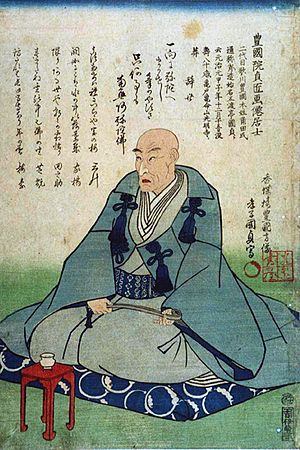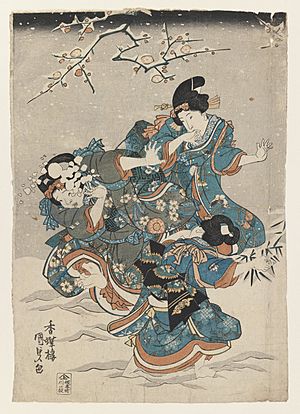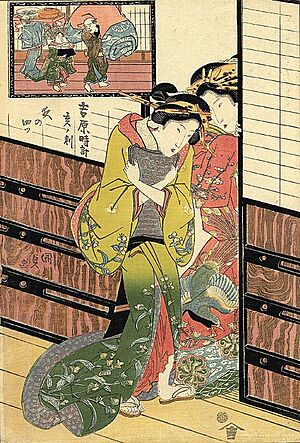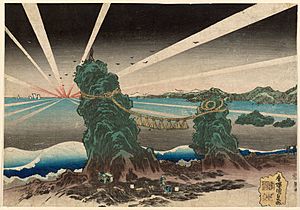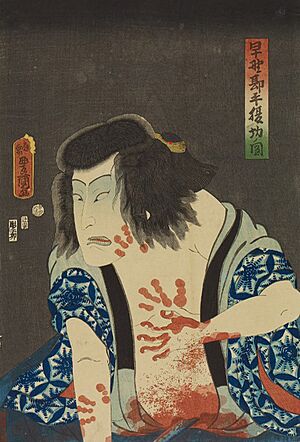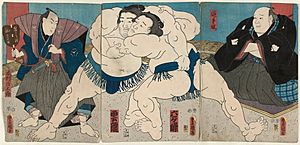Kunisada facts for kids
Utagawa Kunisada (1786 – 1865) was a famous Japanese artist. He was also known as Utagawa Toyokuni III. Kunisada created many ukiyo-e artworks. These were special woodblock prints popular in 19th-century Japan.
He was one of the most popular and successful print designers of his time. Many people bought his art. During his life, his fame was even greater than other well-known artists like Hokusai and Hiroshige.
Contents
Kunisada's Place in Art History
During the late Edo period (1603–1867), Kunisada, Hiroshige, and Kuniyoshi were top Japanese woodcut artists. However, for a long time, art collectors in Europe and America thought their work was not as good as older ukiyo-e art. Some even called their art "decadent," meaning it was seen as declining in quality.
Later, in the 1930s and 1970s, people started to appreciate Hiroshige and Kuniyoshi more. They are now seen as masters of their art. But Kunisada's work was still not fully recognized. Many thought he only made lower-quality prints, except for some early actor and beautiful women portraits.
This view began to change in the 1990s. New studies showed that Kunisada was actually a "giant" in Japanese printmaking. His true importance in art history is now much clearer.
About Kunisada's Life
We don't know every detail of Kunisada's life. But we have good records of some important events. He was born in 1786 in Honjo, a part of Edo (which is now Tokyo). His birth name was Sumida Shōgorō IX.
His family owned a small ferry-boat business. This gave them enough money for Kunisada to pursue his artistic interests. His father, who was a poet, died when Kunisada was very young.
Kunisada showed a talent for drawing early on. His first sketches impressed Toyokuni, a great master of the Utagawa school. Around the year 1800, Kunisada became Toyokuni's student. Following tradition, he was given the artist name "KUNI-sada." The "KUNI" part came from his teacher's name, Toyo-KUNI.
Kunisada's first known print was made in 1807. He started illustrating e-hon (woodblock print books) in 1808. His popularity grew very quickly. By 1809, people called him the "star attraction" of the Utagawa school.
He soon became as good as his teacher, Toyokuni, in book illustration. Kunisada's first actor portraits appeared around 1808 or 1809. By 1813, he was a major "star" in Edo's art world. A list of top ukiyo-e artists placed him second, right after Toyokuni I. Kunisada remained a leading artist until he died in 1865.
Around 1810, Kunisada started using the studio name "Gototei." This name was a hidden reference to his father's ferry-boat business. He used this name on most of his kabuki prints until 1842. Later, around 1825, he used "Kochoro" for prints not related to kabuki.
In 1844, he took on his master's name, Toyokuni I. He signed his prints as "Kunisada becoming Toyokuni II." From 1844–1845, he signed all his prints as "Toyokuni." Even though he called himself "Toyokuni II," he is known today as "Toyokuni III." This is because he chose to ignore another student, Toyoshige, who had also used the name Toyokuni.
Kunisada died on January 12, 1865. He passed away in the same neighborhood where he was born.
Kunisada's Artistic Works
From the start of his career until his death, Kunisada was a trendsetter in Japanese woodblock prints. He always kept up with public tastes. He constantly changed his style and did not stick to what other artists were doing.
He was incredibly productive. Experts have counted about 14,500 different designs he created. This means he likely made between 20,000 and 25,000 designs in his lifetime.
Following the Utagawa school's style, Kunisada mainly focused on kabuki and actor prints. About 60% of his designs are in this category. He also made many bijin-ga prints, which are portraits of beautiful women. He made more of these than any other artist of his time.
From 1820 to 1860, he was also the main artist for sumo wrestler portraits. For a long time (1835–1850), he had almost full control over prints related to The Tale of Genji. Other artists only started making similar designs after 1850. He also made many surimono prints, which were special, often privately ordered prints.
Kunisada's paintings, which were made for private buyers, are not as well known. He also illustrated many books. Some of his book illustrations include shunga pictures. These were often signed with his other name, "Matahei," due to censorship rules.
Kunisada made very few landscape prints or musha-e (samurai warrior prints). He left these types of art to his friends Hiroshige and Kuniyoshi.
In the mid-1840s and early 1850s, woodblock prints were very popular in Japan. During this time, Kunisada worked with Hiroshige and Kuniyoshi on several big series. They did this to show unity against strict censorship rules. Later, in the mid-1850s, some of his prints included parts designed by his students. This helped his students become known artists themselves. Famous students of Kunisada included Toyohara Kunichika and Utagawa Kunisada II.
Most of Kunisada's work showed actors in popular plays or women in the latest fashions. These prints quickly went out of style. This meant there was always a demand for new prints to replace the old ones.
Collections
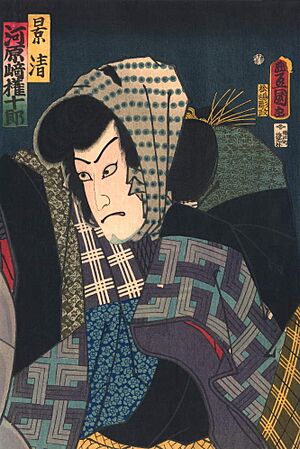
Recent Exhibits:
- A Third Gender, Royal Ontario Museum & Japan Society, 2017
- Showdown!, MFA Boston, 2016
- Utagawa, Brooklyn Museum of Art, 2008
- Living for the Moment: Japanese Prints from the Collection of Barbara S. Bowman, LACMA, 2006
Featured in Major Collections:
- British Museum
- Evansville Museum of Arts, History and Science
- Minneapolis Institute of Art
- Metropolitan Museum of Art
- Museum of Fine Arts, Boston
- Los Angeles County Museum of Art
- University of California, Berkeley
- Vanderbilt University Fine Arts Gallery
See also
 In Spanish: Utagawa Kunisada para niños
In Spanish: Utagawa Kunisada para niños
- Utagawa school
- List of Utagawa school members


